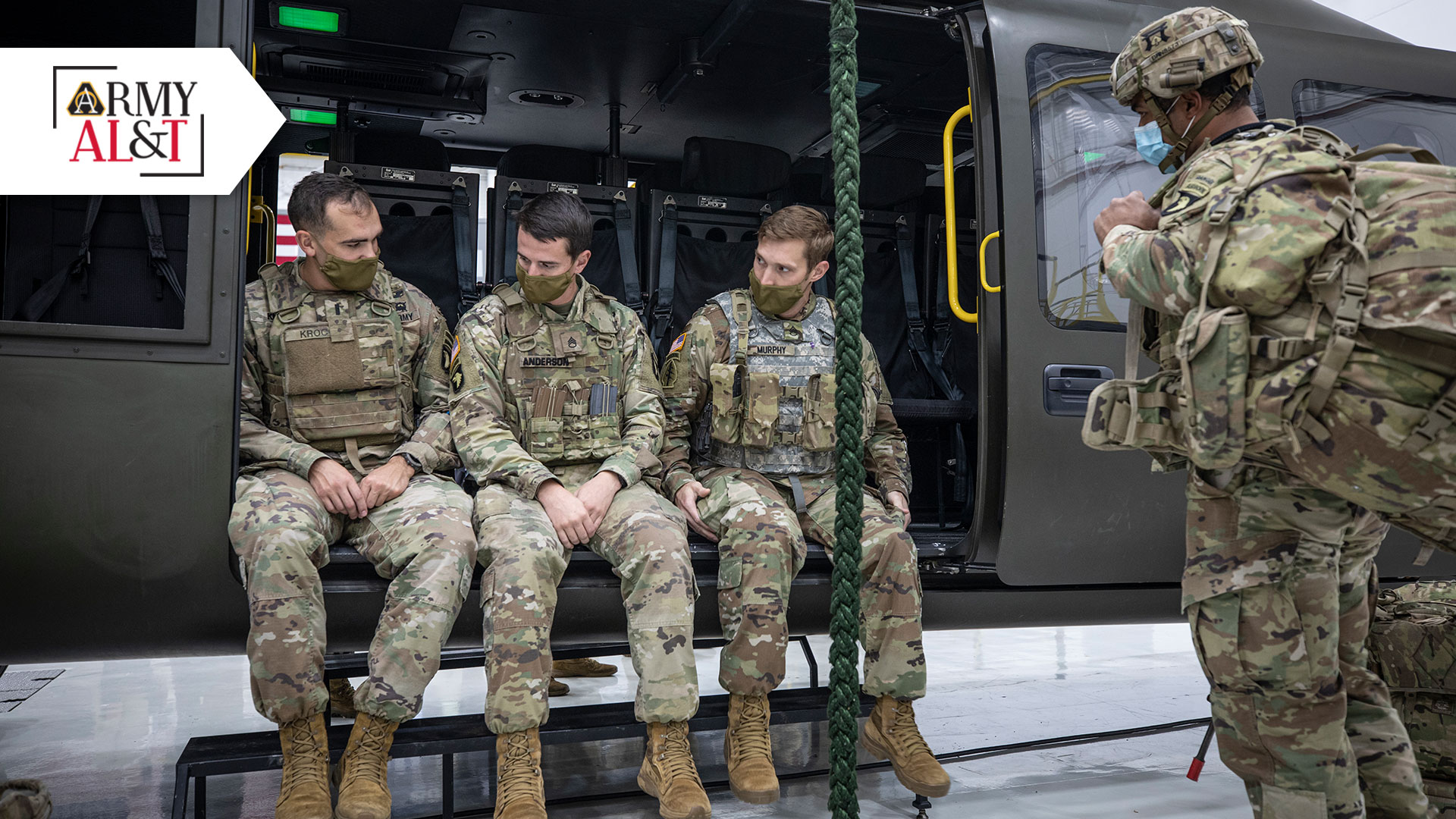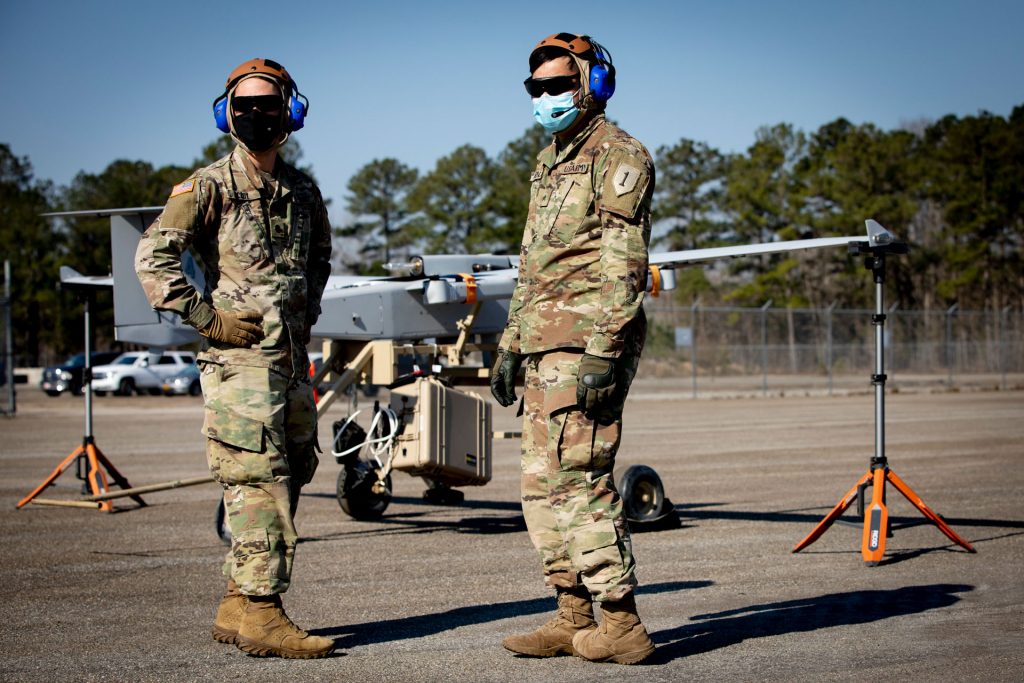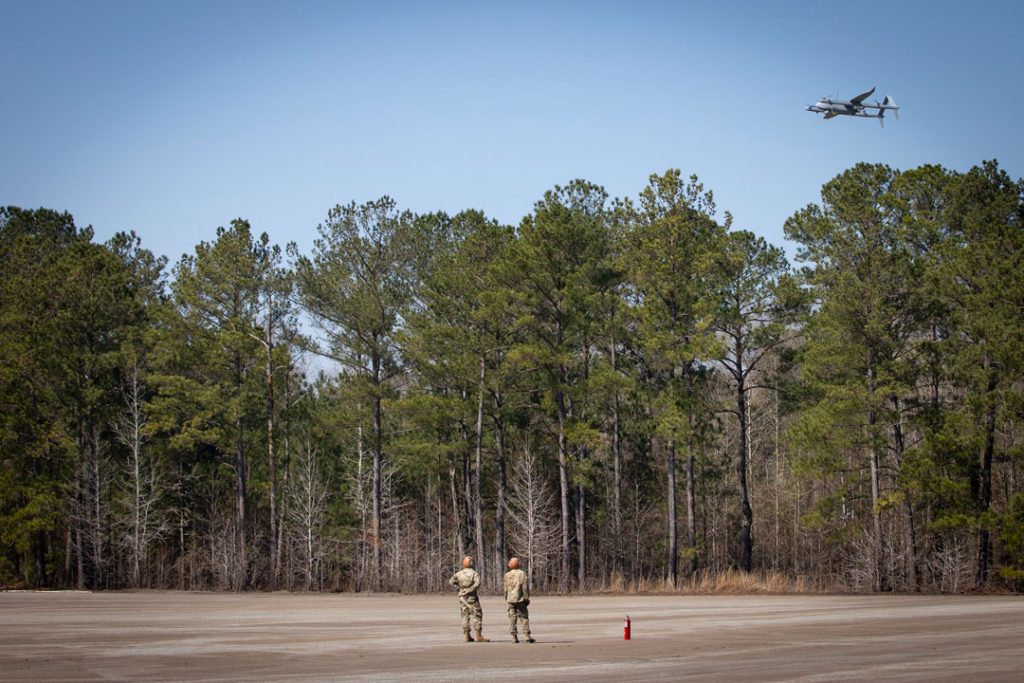
TEST DRIVE: Members of 3rd Brigade Combat Team “Rakkasans,” 101st Airborne Division, provide feedback on the V-280 Valor’s cabin configuration in October 2020 at Bell Flight’s facility in Arlington, Texas. (Photos by Luke J. Allen, Army Futures Command)
Early input from Soldiers during systems development informs capability requirements and improves Army aviation modernization.
by Lisa Ferguson
U.S. Army Futures Command (AFC) embraces the mantra “Winning matters, but winning together matters more,” in its efforts to provide Soldiers with the right capability at the right time to ensure overmatch against our adversaries in multidomain operations. Through a strong partnership with the assistant secretary of the Army for acquisition, logistics and technology (ASA(ALT)), AFC’s subordinate units have taken innovative measures to modernize our Army. One example of this is the application of Soldier-centered design to Future Vertical Lift signature modernization efforts.
Soldier-centered design is a holistic change in how the Army generates capabilities—it puts users at the forefront of the development process, emphasizing early and frequent feedback from Soldiers. Involving Soldiers early in the design process allows the Army to get the requirements right and field useful weapons systems to the warfighter at the time of need. AFC’s Future Vertical Lift Cross-Functional Team (FVL CFT) has taken such an approach with its requirements development for Future Tactical Unmanned Aircraft Systems and Future Long Range Assault Aircraft by leveraging Soldier touch points, where Soldiers can test prototypes and provide feedback.
“The best people to assess these capabilities are the operational Soldiers, the Soldiers living it every day,” explained Sgt. Maj. Joseph Aird, the FVL CFT operations sergeant major.

READY TO TAKE WING: Army Futures Command’s Future Vertical Lift Cross-Functional Team, in conjunction with the Program Executive Office for Aviation, the Aviation Capabilities Development and Integration Directorate and the Maneuver Battle Lab, conduct flight tests in February at Leyte West Airfield, Fort Benning, Georgia.
THE TEAM
Teaming up with ASA(ALT)’s Program Executive Office for Aviation, the FVL CFT conducted a yearlong Soldier touch point with five active-duty brigade combat teams: 2nd Brigade Combat Team, 101st Airborne Division, Fort Campbell, Kentucky; 3rd Armored Brigade Combat Team, 1st Armored Division, Fort Bliss, Texas; 3rd Brigade Combat Team, 82nd Airborne Division, Fort Bragg, North Carolina; 1st Armored Brigade Combat Team, 1st Infantry Division, Fort Riley, Kansas; and 1st Brigade Combat Team, 2nd Infantry Division, Joint Base Lewis-McChord, Washington. Each brigade combat team was issued a commercial off-the-shelf unmanned aircraft system (UAS) to employ and assess at home station training and at one of the Army’s combat training centers. Soldier feedback was captured and used in developing requirements for replacing the Army’s RQ-7 Shadow UAS.
The Shadow is a particularly noisy UAS to launch and recover, and one of the concerns that Soldiers expressed was that the noise made it difficult for them to communicate with each other.
“We’re used to screaming at each other and having to use radios in order to communicate,” said Spc. Christopher McCoy, a crew chief assigned to 1st Engineer Battalion, 1st Armored Brigade Combat Team. “You can stand right next to this aircraft and not even raise your voice.”
In addition to needing a quieter UAS, the Army also wants it to be expeditionary, runway-independent, and provide commanders maneuverability and flexibility on the battlefield. The Future Tactical UAS can be rapidly deployed into a theater of operation with a minimal strategic airlift requirement versus the Shadow. The Shadow requires a dedicated runway with specific lengths and clearance requirements, while the Future Tactical UAS can be transported organically by Army aviation and ground assets. Soldiers can maneuver the Future Tactical UAS around the battlefield and launch from nearly anywhere to meet the commander’s intent. The Shadow also requires large, logistically burdensome ground controls stations and supporting equipment. In contrast, the Future Tactical UAS will have on-the-move command-and-control capability that can be accomplished by a Soldier and a laptop.
“Every day, we tear down everything. All of us tear down what we set up to fly and then put it back up in the morning,” Spc. Anthony Karl, 1st Armored Brigade Combat Team, 1st Infantry Division, said about the systems during the touch point event. “We wouldn’t be able to do that on Shadow. There’s just no way.”

BUCKLE UP: A Soldier from 3rd Brigade Combat Team “Rakkasans,” 101st Airborne Division, evaluates a seat harness on a V-280 Valor at Bell Flight’s facility in Arlington, Texas, in October 2020.
THE RODEO
The yearlong Soldier touch point culminated with a Future Tactical UAS rodeo at Fort Benning, Georgia, in March 2021. Senior leaders from across the Army observed the participating Soldiers operating their assigned systems in a flight demonstration. The feedback garnered and data collected throughout the assessment contributed to the development of well-informed requirements in less than 18 months, with approval through the Army Requirements Oversight Council. The Army will publish a request for proposals and go through a selection process for a planned initial fielding in fiscal year 2023.
The FVL CFT teamed up this time with the U.S. Army Combat Capabilities Development Command Aviation & Missile Center to conduct several Soldier touch point events with the Joint Multi Role Technology Demonstrator (JMR-TD) program. The government-industry shared investment in two flying technical demonstrators has provided significant knowledge points for advanced vertical lift technologies supporting the development of a UH-60 Black Hawk replacement with a Future Long Range Assault Aircraft. The JMR-TD aircraft—the Bell V-280 Valor and the Sikorsky-Boeing SB1 Defiant—provided opportunities for several Soldier touch points, where on multiple occasions the Army has had pilots, crew chiefs, aircraft mechanics and infantry Soldiers assess each of the aircraft and provide feedback.
As members of the rifle squad conducted ingress and egress drills with their full kit, engineers took copious notes from comments on the cabin configuration, seat layout, restraint harnesses and headrests of the V-280. “The headrests were somewhat of a hindrance when wearing the Kevlar helmet and would most likely be worse if we had our NODs [night optical/observation devices] attached,” commented Sgt. 1st. Class Vuthy Hamm, an operations sergeant for the 2-506th Infantry, 101st Airborne Division.
“They took all of our feedback and were super interested in what we had to say about the aircraft,” 1st Lt. Gabriel Marsan, 3rd BCT, 101st Airborne Division said. “I think these touch points are valuable, because it brings the Soldier’s input into the design phase.”

BUY, TRY, INFORM: Army Futures Command’s Future Vertical Lift Cross-Functional Team conducts test flights at Fort Benning as part of a “buy, try, inform” approach to rapidly develop informed requirements for a replacement for the RQ-7 Shadow UAS.
CONCLUSION
Continued collaboration while leveraging innovative approaches like Soldier-centered design to develop requirements and streamline acquisition processes will ensure the Army gets the right capability into the hands of the warfighter today—not 10 years from now.
When asked if he thought the Soldier touch point was worthwhile, Hamm responded, “In 16 years, I’ve never been asked for my input on a new piece of equipment. I’m honored to have our input and suggestions heard and hopefully impact future Soldiers.”
For more information, go to armyfuturescommand.com.
LISA FERGUSON is the communications director for the Future Vertical Lift Cross-Functional Team, located at Redstone Arsenal, Alabama. She graduated from Troy University with a B.S. in print journalism and public relations in 2003 and completed Defense Information School in 2004. She’s spent more than 11 years in public affairs for the federal government, including the U.S. Air Force, the U.S. Army and the U.S. Department of Agriculture.







